 Loading... Please wait...
Loading... Please wait...All prices are in All prices are in EUR
Categories
- Home
- Blog History Revisited
- Dr Suess
Blog History Revisited - Dr Suess
The Golden Age of Enchantment 1860-1930
Posted by ©Sandra JI Ker, Antiquarian Print Gallery, South Australia 1989-2015. Dealer in Antique Prints and Maps, http://www.historyrevisited.com.au on 3rd Dec 2015
Definition of Childhood
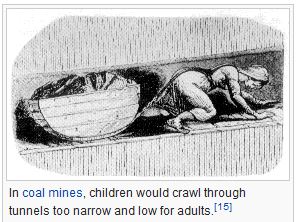
Two Monumental tides have changed & challenged Planet Earth since the mid-1600s: The Age of Enlightenment gave a voice to Philosophers and Scientists who became the fertilizer for the Industrial Revolution . Inventors armed with the newfound scientific discoveries invented labour saving devices. Factories manufactured volume therefore creating “economy of scale” savings. Western Society was no longer dominated by the Noble and Serf classes: a new class had moved into the neighbourhood. This was the energetic Merchant, or Middle class. "New Wealth”, instead of perceiving a child of Seven an adult, sending them down the mine as a matter of necessity, they had time to indulge their children. The idea of “Childhood” as we know it, was a by-product. These new factories made affordable toys. Education, once the domain only of the nobility, was filtering down through the publication of affordable books of knowledge. This was the mission statement of Johann Gutenberg, the inventor of the Printing Press circa 1452.
Adults = “obsolete children”?

Most children are adults eventually. Learning how to hunt and gather is essential knowledge to nurture the following generation. Even so, each adult love to hear a child’s laughter, delight in their imaginative view of reality. Maybe we adults need to accept, like Dr. Suess has predicted, "...adults are obsolete children". That memory of childhood, the lessons we learned that made us wiser, that make us ideal story tellers, that made us adults. It is those “obsolete children” that are the dedicated Children’s authors that require the imaginations of illustrators to embellish them. Adults become the investors in fine art, antique prints and first edition books, some in Self-Managed Superannuation Funds and shy not, it's their fund! All generations owe much to the privilege of having a post Age of Enlightenment fuelled Industrial Revolution “childhood".
Benefits of Travel & Culture : Thomas Cook
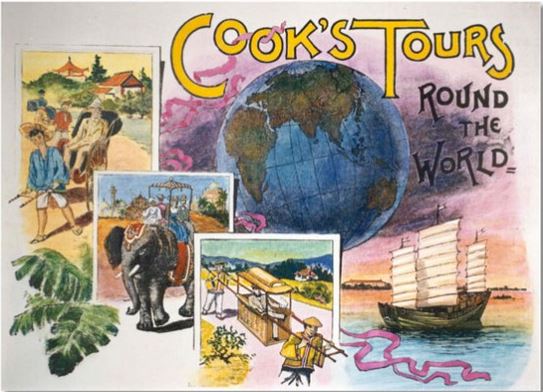
More adults had the capacity to travel, to enjoy the exotic delights, once only the domain of the noble class “Grand Tours”. Thomas Cook organized county excursions to London Great Exhibition in 1851 where “you could see the world for a penny” without leaving British shores. The British Empire was extending into exotic regions of the world, being exposed to new cultures of colour, culinary experiences and cultures. India had been dubbed the Jewel in the (British) Crown and with Commodore Perry's opening feudal Japan with his four steam warships in 1853 the impact Japanese Art would have on Western art and design was to be far-reaching. Indeed, many Illustrators bear witness to this influence.
Colour Printing Techniques = Artistic Commercial Opportunity
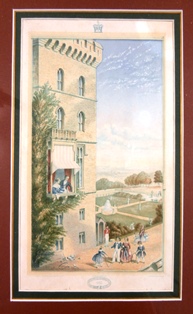 Enter a knew generation of artist/illustrator who identified a market of merchant-class adults who wished not only to educate their children but to entertain them with whimsical stories. Black and white illustrations, hitherto hand coloured, were now being influence by pastel tones or vibrant colour.
Enter a knew generation of artist/illustrator who identified a market of merchant-class adults who wished not only to educate their children but to entertain them with whimsical stories. Black and white illustrations, hitherto hand coloured, were now being influence by pastel tones or vibrant colour.
George Baxter (see left, Prince Albert and Queen Victoria at Windsor Castle) invented the first commercially viable “printing in colour” technique from metal plates in the 1850s., Chromoxylography was colour-ink printing from wood blocks, and chromolithography was colour printing using greasy crayon and Limestone blocks. Prior to these techniques colour had been hand applied to black and white images, with watercolour & gouache organic pigments. New colour printing techniques made the most of “economy of scale” thanks to middle class affluence increasing affordability, as well as, attractive to the Victorian Era Consumer.
In the 1860s London had become the printing hub mecca for European Illustrators attracted to its printing houses for such variety, versatility, affordability. Chromoxylography was taken on by printer Edmund Evans who catered to growing ranks of Golden Age illustrators. The technique was made famous for the crudely coloured “Penny Dreadfuls” comics and illustrations etc. Evans reacted against that trend deciding to use the same process to produce higher quality children's and toy books. Evans believed this technique was beautiful and inexpensive if the print run was large enough to maintain the costs. In doing so, Evans collaborated with Kate Greenaway, Walter Crane and Randolph Caldecott all remembered for their beautiful gift books engraved and printed by Evans.
Printing Evolution: Gravures & Fairy Tales
The next wave of influential Illustrators were propelled by another revolutionary printing process, Gravuring. Adapted from the fabric industry to more efficiently replicate pattern on fabric, it used light sensitive Gelatine, copper plates, chemicals and gauze. In essence it utilized the artists original artwork without the need for adaptation by an engraver or lithographer, essentially a third person, interpreting the artist’s work. Where the fabric industry used dyes, the printing industry used coloured inks. When the ink was trapped in a honey-comber gauze applied to the gauze, the cell walls prevented the colours "bleeding, behaving like watercolour pigments mixing in water. the finished product mimicked watercolour on the page. It was, therefore, a perfect medium for an illustrator to replicate in-demand illustrations, therefore income.
Arthur Rackham (1869-1939)
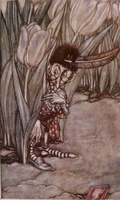 Dubbed the “Beloved Enchanter” by critics his name evokes images of gnomes, fairies, dragons, knights and princesses, all a direct inspiration for Walt Disney decades later. Menacing forests and gnarled woods full of sinister personalities counter fairies who "believe nothing is more playful than a leaf" (Peter Pan). This balance of good and evil reminds us that lessons conveyed by stories and illustrations may not be so effective if they are all soft and fluffy. All the best stories have good countered by bad, with hopefully good "saving the day". The life of an artist/illustrator is a point in fact! Rackham had left his Job as a clerk to pursue his dream of illustrating. He quickly established himself as the goto leading decorative illustrator and for many years no Christmas would have been complete without a Rackham illustrated gift book. Indeed, he contributed to many Red Cross Fund raisers during the war, as many illustrators did “to do their bit”. In 1906 a critic said of his Peter pan in Kensington Gardens, “Mr Rackham seems to have dropped out of some cloud in Mr Barrie’s fairyland...to make pictures in tune with his whimsical genius.”
Dubbed the “Beloved Enchanter” by critics his name evokes images of gnomes, fairies, dragons, knights and princesses, all a direct inspiration for Walt Disney decades later. Menacing forests and gnarled woods full of sinister personalities counter fairies who "believe nothing is more playful than a leaf" (Peter Pan). This balance of good and evil reminds us that lessons conveyed by stories and illustrations may not be so effective if they are all soft and fluffy. All the best stories have good countered by bad, with hopefully good "saving the day". The life of an artist/illustrator is a point in fact! Rackham had left his Job as a clerk to pursue his dream of illustrating. He quickly established himself as the goto leading decorative illustrator and for many years no Christmas would have been complete without a Rackham illustrated gift book. Indeed, he contributed to many Red Cross Fund raisers during the war, as many illustrators did “to do their bit”. In 1906 a critic said of his Peter pan in Kensington Gardens, “Mr Rackham seems to have dropped out of some cloud in Mr Barrie’s fairyland...to make pictures in tune with his whimsical genius.”
Edmund Dulac (1882-1953)
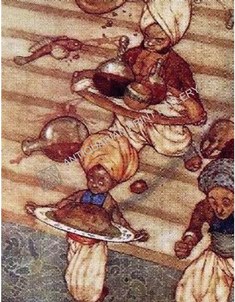 Dulac, a Frenchman in London, was the heir apparent to Rackham. Dulac’s expressive use of colour, yet not expressed by British illustrators, betrayed his passion for Persian art and Indian Miniatures, evoking all the mystery and exoticism of the East. A Critic described his colour plates as “each of three iridescent miniatures which seemed to be made of opal dust on mother of pearl...they are colour feasts for the eye” Another influence may be, that from an early age he spent his holidays copying Japanese wood block prints, a huge influence on Western art in general. He was inspired by the illustrations of Walter Crane and the Great William Morris and soon became an ardent Anglophile. Indeed London, as for many illustrators, was a dream destination. His point of difference was his mastery of the “fantastic and exotic”. His illustrations for Stories of the Arabian Knights remained his most popular work. Dulac followed in 1909 with his translation os the Persian Rubaiyat of Omar Khayyam that shows Dulac at his most imaginative as he embraced the essence of Eastern fantasy both in form and colour.
Dulac, a Frenchman in London, was the heir apparent to Rackham. Dulac’s expressive use of colour, yet not expressed by British illustrators, betrayed his passion for Persian art and Indian Miniatures, evoking all the mystery and exoticism of the East. A Critic described his colour plates as “each of three iridescent miniatures which seemed to be made of opal dust on mother of pearl...they are colour feasts for the eye” Another influence may be, that from an early age he spent his holidays copying Japanese wood block prints, a huge influence on Western art in general. He was inspired by the illustrations of Walter Crane and the Great William Morris and soon became an ardent Anglophile. Indeed London, as for many illustrators, was a dream destination. His point of difference was his mastery of the “fantastic and exotic”. His illustrations for Stories of the Arabian Knights remained his most popular work. Dulac followed in 1909 with his translation os the Persian Rubaiyat of Omar Khayyam that shows Dulac at his most imaginative as he embraced the essence of Eastern fantasy both in form and colour.
Kay Nielsen (1886-1955)
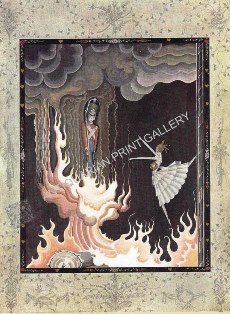 Nielsen a celebrated Danish Artist with a family heavily involved in Danish Theatre. He was inspired to illustrate traditional Norse sagas. He was a brilliant colourist and highly decorative betraying an affinity for the Oriental. Many of his works are strongly reminiscent in quality to middle eastern and Persian designs. All these influences made his depictions less sombre than Rackham. Nielsen was inspired by the old Norse Folklore read to him by his mother as a child. Nielsen’s illustrations of Hans Christian Andersen display his unique style and talent for combining the eerie and fantastic with stunning decorative impact. After an exhibition in New York, Nielsen spent time in Copenhagen designing scenery for the Royal Danish Theatre before returning to illustration in 1924. Hodder & Stoughton printed his illustrations for Hans Andersen’s Fairy Tales. He established his place in the arena of fantasy illustration with artwork for fairy tales. In 1939 he applied his talent to the new medium of storytelling and was employed by the Walt Disney Company from 1937-41. He contributed to many films, most notably sequences in Fantasia. If alive today he would soar to new heights with the Computer-Generated Imaging (CGI) and 3D technology. Others are are harnessing that medium to the same ends, to Enchant the viewer, not only in the Cinema, but on their 3D living room entertainment centres, even using their smart phones.
Nielsen a celebrated Danish Artist with a family heavily involved in Danish Theatre. He was inspired to illustrate traditional Norse sagas. He was a brilliant colourist and highly decorative betraying an affinity for the Oriental. Many of his works are strongly reminiscent in quality to middle eastern and Persian designs. All these influences made his depictions less sombre than Rackham. Nielsen was inspired by the old Norse Folklore read to him by his mother as a child. Nielsen’s illustrations of Hans Christian Andersen display his unique style and talent for combining the eerie and fantastic with stunning decorative impact. After an exhibition in New York, Nielsen spent time in Copenhagen designing scenery for the Royal Danish Theatre before returning to illustration in 1924. Hodder & Stoughton printed his illustrations for Hans Andersen’s Fairy Tales. He established his place in the arena of fantasy illustration with artwork for fairy tales. In 1939 he applied his talent to the new medium of storytelling and was employed by the Walt Disney Company from 1937-41. He contributed to many films, most notably sequences in Fantasia. If alive today he would soar to new heights with the Computer-Generated Imaging (CGI) and 3D technology. Others are are harnessing that medium to the same ends, to Enchant the viewer, not only in the Cinema, but on their 3D living room entertainment centres, even using their smart phones.
Don't be "Obsolete Children"- Remain "Enchant-able".
These are just a few of the illustrators that any generation may have grown up with, either as the child or the parent or grandparent who retold these stories with such glorious illustrations. The progress of technology does not weary these interpretations by the contemporary artist, but ensures they are as much relevant today as they were when created. Each era has Illustrators able to interpret the stories with a modern twist, but the lessons are enduring. These characters can be adapted to modern media with a guarantee to delight and enchant a whole new generation of future "obsolete children".
I would like to think that Dr. Suess is reminding us not to let the Child inside us Never Grow Up! We can look at these images at any age or media and remain "Enchant-able".
For Example: Brian, an enthusiastic Quiz Night frequenter, once asked, "If Koalas hung out in groups, what would we call them?" After some consideration of these solitary yet endearing critters, he suggested "A Cuddle of Koalas"? Brian has remained true to his inner child right there!
© Sandra Ker Antiquarian Print Gallery 1989-2015 South Australia
Recent Posts
- » Lady Sarah Lennox, King George III & The Honourable George Napier
- » Schomburgk's Botanic Garden & Park Plan, 1874
- » "City of Adelaide" Clipper Ship - What is Old Is New Again
- » Napoleon, Hudibrastic Poetry, Doctor Syntax & the Power of Satire
- » Colonial Melbourne to Albury "Parlour Car" Photo Connects to Adelaide Past & Present





